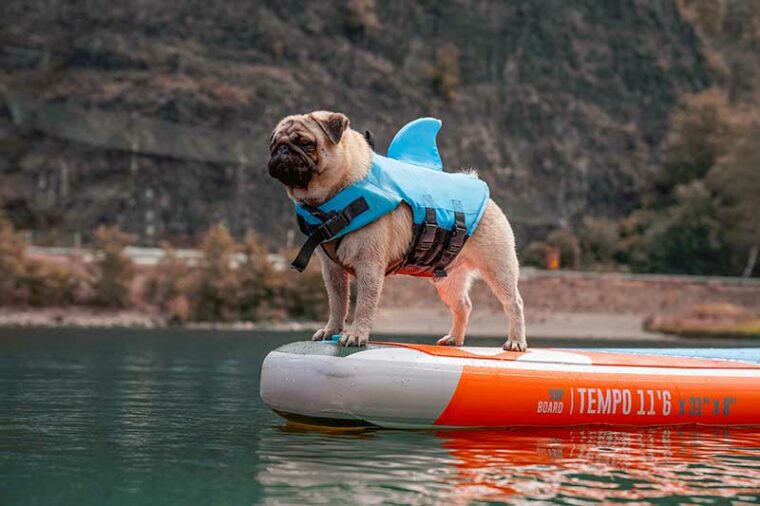
Stand-up paddle boarding (SUP) is a popular water activity that’s fun to do with your dog. It’s a great way to stay cool, have fun, and bond with your pet. If you’ve never tried it, keep reading as we provide a step-by-step guide, along with additional tips to help you get started. We cover preparation, getting on and off the board, and monitoring your pet to ensure that they’re having a good time.

Preparation
Before you try to take your dog paddle boarding, you must ensure that they are comfortable around water and a good swimmer. They should be comfortable wearing a life jacket, and you should have one that fits them comfortably. Before you head out for the day, we also recommend checking the weather to ensure that there are no thunderstorms or high winds that might create dangerous conditions.
Before You Start
Once you are sure your dog is comfortable in the water, pick a paddle board that suits your and your dog’s weight and size. It should be stable and wide to accommodate you both comfortably. You will also need a leash to keep your dog on the paddle board, life jackets for you and your dog, and a paddle for yourself. We recommend practicing on land to help get your dog used to the paddle board. Also, choose a calm and quiet spot away from other activities.
1. Put On Your Dog’s Life Jacket

The first step is to put the life jacket on your dog before entering the water or getting on the paddle board. It should fit snugly without being tight; the goal is for it to help keep your pet afloat in case of an accident.
2. Secure Your Dog
Hook the leash to the paddle board D-ring to help keep your pet secure while on the water. Some experts also recommend using a bungee cord to prevent the leash from tangling in the paddle board fin.
3. Get on the Paddle Board

With your dog attached to the paddle board, you can get on, kneeling to ensure that it’s stable before standing up.
4. Help Your Dog onto the Paddle Board
Next, help your dog onto the paddle board by encouraging them to step on from the rear. It can take a few tries before your pet feels comfortable, so be patient and try not to become frustrated, or your dog might feel like they’re disappointing you.
5. Start Paddling

Once your dog is comfortable on the paddle board, start paddling slowly, keeping your weight centered over the board and maintaining a steady, relaxed pace.
6. Monitor Your Dog’s Behavior
Watch your dog carefully to ensure that they are not uncomfortable or anxious. If they start to pant heavily or begin whining, take a break for a few minutes to let them catch their breath. Taking frequent breaks will also help reinforce that this is a fun, relaxed activity, which can help your pet feel more comfortable.
7. Take Plenty of Breaks

Even if your pet isn’t showing signs of distress, we recommend taking frequent breaks so your pet can drink water and rest in the shade to prevent them from overheating, especially when using the paddle board on a hot day.
8. Always Help Your Dog Off First
When it’s time to return to shore, approach it slowly and slow down. When you reach the edge, help your dog get off first before getting off yourself so you can keep the paddle boat stable.

Other Tips for Paddle Boarding With Your Dog

Conclusion
Paddle boarding with your dog can be a fun and enjoyable experience, but it’s important to be well-prepared and safe before heading out onto the water. Take it slow, and monitor your dog to ensure that they aren’t suffering from anxiety or motion sickness. Start with short trips along this shore, gradually taking longer adventures as your pet seems more comfortable. Always get on the paddle board first and leave it last so you can help keep it stable as your dog gets on and off, and enjoy your bonding time with your pet.
Featured Image Credit: BLACK LEMON, Shutterstock



